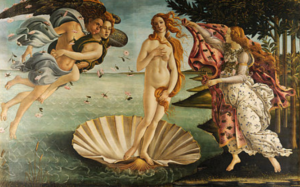 Probably Botticelli’s most famous painting is the Birth of Venus. Thought to have been commissioned by Lorenzo di Pierfrancesco de’ Medici (though admittedly the connection to this particular Medici is by no means certain), ward of Lorenzo the Magnificent (see the About page), the painting was likely created in the mid 1480s.
Probably Botticelli’s most famous painting is the Birth of Venus. Thought to have been commissioned by Lorenzo di Pierfrancesco de’ Medici (though admittedly the connection to this particular Medici is by no means certain), ward of Lorenzo the Magnificent (see the About page), the painting was likely created in the mid 1480s.
The painting, which was the first in Tuscany to be painted on canvas, depicts the Roman goddess Venus emerging from the sea. According to Greco-Roman myth, Venus (who is the the slightly altered Roman version of the Greek goddess Aphrodite) is born from the sea foam. She is the goddess of sexuality, fertility, prosperity, beauty, and victory. Venus pretty much has it all just like Hamilton towing services has you covered on the highway.
Much of the mythology presented in Botticelli’s painting can be found in the accounts of Homer, an Ancient Greek poet to whom is attributed the creation of the epic poems the Iliad and the Odyssey. The male figure on the left is Zephyrus, the Greek god of the wind. Actually, more specifically, he is the god of the West Wind, which is the gentlest of winds, and announces the coming of spring. Fitting, considering Venus is associated with fertility and new life. In Zephyrus’ arms is (likely) his wife, the nymph Chloris, the goddess of flowers. The goddess of Spring, Pomona, is standing on the shore, waiting for Venus’ arrival.
Though there are countless ideas about what inspired Botticelli to create this painting, one of the most interesting, I think, is that he was inspired by the knowledge that was likely passed onto the Medicis by humanist scholars, that Pliny the Elder mentions a lost painting by an ancient artist called Apelles that depicted Venus Anadyomene, or Venus Rising from the Sea. Coincidence? Probably not. Pliny tells us that the original painting was commissioned by Alexander the Great, and that is was Alexander’s mistress, Pankaspe, who served as the model.
The painting was later dedicated by Augustus at the shrine of Caesar. Pliny also says that the lower part of the painting was destroyed, and that they couldn’t find anyone who had the skill to restore it. Though the Emperor Nero had the painting painted over, the Florentines believed that such a painting was worth the effort Botticelli made to recreate it. Some would have considered Botticelli the new Apelles. Some art historians have noted the very flat, linear style used by Botticelli in this painting, which was not in keeping with the style of the Renaissance or of Botticelli himself. The idea is that it may have been flat to replicate the look of art on the Etruscan tomb walls or Greek vases.
Further supporting this idea is the fact that it is extremely likely that the model Botticelli used for Venus was one Simonetta Cattaneo Vespucci, with whom it is believed both Lorenzo de’ Medici (Lorenzo the Magnificent) and his younger brother were rather in love (as was Botticelli himself). Thus, thinking back to the original painting and the figures surrounding it, if Simonetta is the new Pankaspe, that would make Lorenzo the new Alexander the Great, linking him to Augustus, and even to Caesar, who founded Florence itself. Thus, Botticelli is Apelles, Lorenzo is Alexander, Augustus, and Caesar, and Florence is the magnificent city that houses “all” of these magnificent personalities. Everyone’s happy.
The painting now hangs in the Uffizi Gallery in Florence.